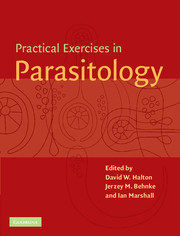Book contents
- Frontmatter
- Contents
- List of contributors
- Preface
- General advice
- 1 Observational Exercises on Parasites
- 2 Ecology
- 2.1 Pin worms (Nematoda, Oxyuroidea) in the American cockroach, Periplaneta americana
- 2.2 Distribution and microhabitat of a monogenean on the gills of mackerel
- 2.3 Population dynamics of Gyrodactylus on stickleback
- 2.4 Intraspecific competition in the cestode Hymenolepis diminuta, in rats
- 2.5 Transmission dynamics and the pattern of dispersion of the cestode Hymenolepis diminuta, in the intermediate host population
- 3 Physiology and Biochemistry
- 4 Pathology and Immunology
- 5 Chemotherapy
- 6 Molecular Parasitology
- 7 Behaviour
- Appendix 1 Reagent index
- Appendix 2 UK suppliers
- Appendix 3 US suppliers
- Index
2.5 - Transmission dynamics and the pattern of dispersion of the cestode Hymenolepis diminuta, in the intermediate host population
Published online by Cambridge University Press: 05 June 2012
- Frontmatter
- Contents
- List of contributors
- Preface
- General advice
- 1 Observational Exercises on Parasites
- 2 Ecology
- 2.1 Pin worms (Nematoda, Oxyuroidea) in the American cockroach, Periplaneta americana
- 2.2 Distribution and microhabitat of a monogenean on the gills of mackerel
- 2.3 Population dynamics of Gyrodactylus on stickleback
- 2.4 Intraspecific competition in the cestode Hymenolepis diminuta, in rats
- 2.5 Transmission dynamics and the pattern of dispersion of the cestode Hymenolepis diminuta, in the intermediate host population
- 3 Physiology and Biochemistry
- 4 Pathology and Immunology
- 5 Chemotherapy
- 6 Molecular Parasitology
- 7 Behaviour
- Appendix 1 Reagent index
- Appendix 2 UK suppliers
- Appendix 3 US suppliers
- Index
Summary
Aims and objectives
This exercise is designed to demonstrate:
The actual transmission rates of cestode eggs to cysticercoids in a beetle host.
The manner in which parasites are dispersed throughout a host population.
The influence of egg density on transmission rates and patterns of dispersion.
Introduction
Transmission of parasites from a free-living stage to a host or from one host to another is always hazardous and associated with high parasite mortality. The probability of a single egg giving rise to a cysticercoid larva in a beetle is very low, in the region of P = 10-1 or less. In nature, much of the mortality is due to beetles failing to encounter eggs, or, having encountered one, failing to become infected. Additional factors reducing transmission rates include shortage of time in which to infect and/or encounters between parasite and resistant host. Even under ideal laboratory conditions, however, the probability of successful infection is low. It can be predicted on the basis of intuition and mathematical models that the probability of a successful infection will relate to the density of parasite eggs relative to that of beetles, such that the greater the egg density, the higher the probability of transmission.
What is not always appreciated is that transmission (a birth/recruitment process) rate can also influence the dispersion pattern of a parasite in a subsequent host population. An understanding of parasite dispersion patterns within their host populations is vital to an understanding of parasite population dynamics, epidemiology and control.
- Type
- Chapter
- Information
- Practical Exercises in Parasitology , pp. 167 - 172Publisher: Cambridge University PressPrint publication year: 2001



